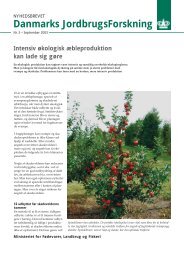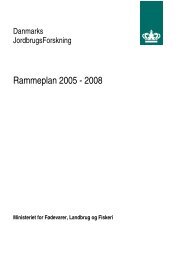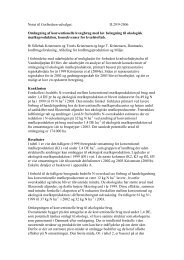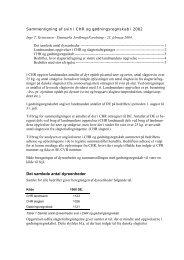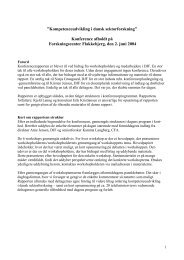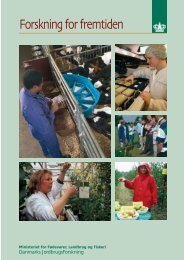Reproduction performances and conditions of group-housed non ...
Reproduction performances and conditions of group-housed non ...
Reproduction performances and conditions of group-housed non ...
You also want an ePaper? Increase the reach of your titles
YUMPU automatically turns print PDFs into web optimized ePapers that Google loves.
- Paper I -<br />
seem to impair the number <strong>of</strong> embryos (Toplis et al., 1983), litter size or farrowing rate<br />
(Sørensen, 1994; Sørensen & Thorup, 2003) in sows.<br />
When looking isolated at energy intake in pregnancy, there is apparently no effect <strong>of</strong> low<br />
energy intake (21.6, 23.0 MJ ME day -1 ) the first four weeks on the number <strong>of</strong> embryos<br />
(Kirkwood et al., 1990), litter size or farrowing rate (Sørensen, 1994). However, this is perhaps<br />
only the case when sows are in a good condition at weaning because Kirkwood et al.<br />
(1990) found a lower number <strong>of</strong> embryos in sows restricted fed during lactation (36.1 MJ<br />
ME day -1 ) <strong>and</strong> the first 25 days <strong>of</strong> pregnancy (21.6 MJ ME day -1 ) compared to sows fed<br />
close to ad libitum in lactation <strong>and</strong> restricted fed the first 25 days <strong>of</strong> pregnancy.<br />
Very low feed intake (10.6 MJ ME day -1 ) day one to day ten in pregnancy did not affect the<br />
number <strong>of</strong> piglets born (total or alive) or the farrowing rate (Dyck & Cole, 1986). However,<br />
as found in the study by Dyck & Strain (1983), it seems that low feed intake only has an<br />
effect after day ten <strong>of</strong> pregnancy, so perhaps a longer period <strong>of</strong> very low energy intake<br />
would have influenced the farrowing rate in sows. This is confirmed in a study by Sørensen<br />
& Thorup (2003) who found that very low energy intake (13 compared to 49 MJ ME day -1 )<br />
the first 28 days in pregnancy, reduced the litter size significantly.<br />
All in all, there seems to be no evidence that high (≥38.4 MJ ME day -1 ) energy intake in the<br />
first 28 days <strong>of</strong> pregnancy impair the litter size in sows. It seems that low energy intake<br />
(21.6 MJ ME day -1 ) the first four weeks <strong>of</strong> pregnancy may impair the litter size only in<br />
sows fed very restricted during lactation. Very low energy intake (10.6 MJ ME day -1 ) the<br />
first ten days in pregnancy does apparently not impair the litter size or the pregnancy rate<br />
but very low energy intake (13 MJ ME day -1 ) for a longer period (28 days) may impair the<br />
litter size.<br />
4. Effect <strong>of</strong> energy intake in mid-/late pregnancy <strong>and</strong> in several successive pregnancies<br />
In Table 3, the results from the seven studies presented in this chapter are summarized. In<br />
these experiments, the effect <strong>of</strong> energy intake in mid- <strong>and</strong> late pregnancy <strong>and</strong> in several<br />
successive pregnancies on number <strong>of</strong> embryos; litter size <strong>and</strong>/or culling rate has been studied.<br />
34




